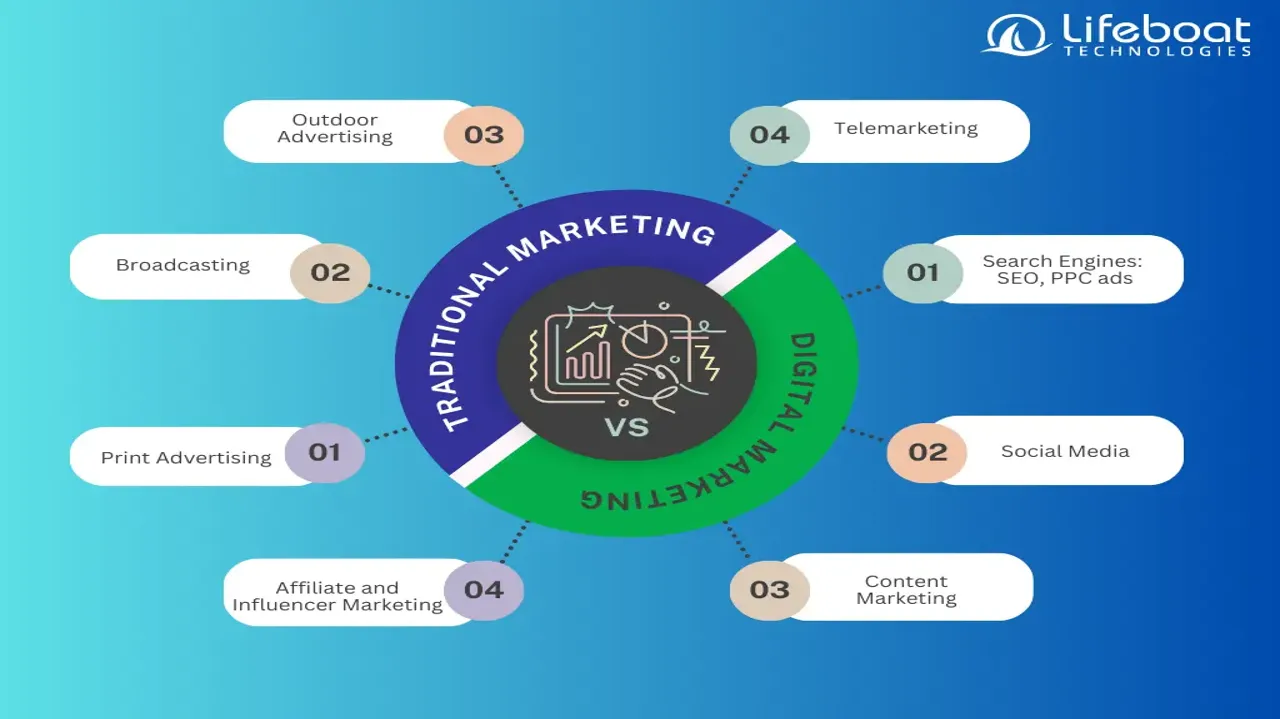

Marketing has been the strong backbone for every business that exists, to reach out to their audience. Where technology is continuously evolving, similarly, marketing strategies are also evolving at their own pace. Today, businesses have basically two kinds of main marketing aspects: digital marketing and traditional marketing. Both types have their positives and negatives, but they work for diverse audiences and use different means. This blog will go into the differences between digital and traditional marketing techniques, their benefits, and when exactly to use which.

What is traditional marketing?
Traditional marketing includes those methods employed over many years before the emergence of the internet. These include a range of offline techniques such as:
- Print Advertising: Newspapers, magazines, brochures, and flyers.
- Broadcasting: Commercials in TV and radio.
- Outdoor Advertising: Billboards, posters, and transit ads.
- Direct Mail: Catalogs, postcards, and letters sent to consumers.
- Telemarketing: Calls are made to possible customers on their phones.
The aim would be to use traditional marketing mainly for brand awareness, building credibility, and reaching out to a wide audience. It is a form of marketing that many people are familiar with and might tend to trust more since it has been in use for years.
What is digital marketing?
Contrary to that, digital marketing is a fairly new approach in which products and services are marketed via digital channels such as:
- Search Engines: Through SEO or Pay Per Click (PPC) ads.
- Social Media: Through Facebook, Instagram, Twitter, and LinkedIn. radio.
- Email Marketing: Sending promotional emails or newsletters.
- Content Marketing: Blogs, videos, and infographics designed to attract and engage an audience.
- Affiliate and Influencer Marketing: Within this strategy, one partners with other people or websites to sell products.
Digital marketing has grown along with the growth of the internet. Business owners can use it to target a particular demographic quite easily, monitor its performance in real time, and make adjustments where needed.
Key Differences::
-
Reach and Accessibility:
Digital marketing is accessible to all over the world, while traditional marketing has its own confined geographic area. -
Cost:
Digital marketing is usually cheaper compared to traditional methods of marketing. -
Measurability:
The results in digital marketing are measurable, while in traditional marketing sometimes it gets hard to track the metrics. -
Targeting:
Digital marketing can be very specific, whereas traditional marketing often uses larger demographics. -
Flexibility:
It is easy to edit or pause a digital marketing campaign, and traditional marketing campaigns usually are set in stone. -
Speed:
The results for digital marketing come out much faster, whereas in traditional marketing, it takes several months to get any return on investment out. -
Engagement:
Digital marketing encourages two-way communication, while traditional marketing is often one-way.
Conclusion :
These days, every business has to try and accommodate themselves with the pace at which the marketing world is changing. While traditional marketing still holds its place, more strength lies in digital marketing for effectively, efficiently, and measurably reaching your target audience. Knowing the differences between digital marketing and traditional marketing will help a business make a comprehensive marketing strategy that leverages the strengths of each.Contact us at contact@lifeboat.co.in for more information.


